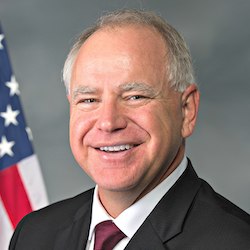
Washington, D.C., March 28 – Amid a trend of nationwide job growth for people with disabilities, Minnesota is outperforming far bigger states like California and Texas. According a new report by the nonpartisan advocacy group RespectAbility, the North Star State now ranks 5th in the nation for employment of people with disabilities.
The newly published 2018 Annual Disability Statistics Compendium shows that Minnesota currently has an employment rate of 47.8 percent for its citizens with disabilities. Out of 305,082 working-age (18-64) Minnesotans with disabilities, 145,697 have jobs.
Newly elected Gov. Tim Walz already has signaled a serious commitment to promoting inclusion across the state. The first executive order signed by the governor created a new One Minnesota Council on Diversity, Inclusion, and Equity. This Council follows the leadership shown by Gov. Walz’ predecessor Gov. Mark Dayton who made diversity a key priority for his administration.
“My first executive order will help ensure every action by our administration is done through the lens of One Minnesota,” Gov. Walz said in a press release. “Disparities in Minnesota, including those based on race, geography, and economic status, keep our entire state from reaching its full potential. If we are going to address these challenges, we must work hand-in-hand with the communities themselves. This council will help give a voice to all Minnesotans, whether they live on the East Side of St. Paul or in East Grand Forks.”
“Our nation was founded on the principle that anyone who works hard should be able to get ahead in life,” said Jennifer Laszlo Mizrahi, president of RespectAbility. “People with disabilities deserve the opportunity to earn an income and achieve independence, just like anyone else.”
A National Issue
Beyond Minnesota, how is the workforce changing for people with disabilities? What is driving these changes? The answer is simple. According to Vincenzo Piscopo of the Coca-Cola Company: “People with disabilities bring a unique skill set that it is very valuable for companies.” He went on to add, “As it relates to employment and competitiveness in the workplace, we have to stop thinking of disability as a liability and start thinking of it as an asset.”
Brand-name companies such as JP Morgan Chase, Coca-Cola, Ernst & Young, IBM, Walgreen’s, Starbucks, CVS and Microsoft show people with disabilities are successful employees. These companies also know that these workers improve the bottom line. “People with disabilities bring unique characteristics and talents to the workplace,” said RespectAbility President Jennifer Laszlo Mizrahi. “Hiring people with disabilities is a win-win-win for employers, people with disabilities and consumers alike.”
As more companies hire employees with disabilities, conversations are shifting to focus on inclusion. “Disability inclusion is no longer about automatic doors, curb cuts, ramps, and legislation,” says Jim Sinocchi, Head of the Office of Disability Inclusion at JP Morgan Chase. “Today, the new era of disability inclusion is about “assimilation” – hiring professionals with disabilities into the robust culture of the firm.”
According to the Census Bureau, there are more than 56 million Americans living with a disability. Disabilities include visible conditions such as spinal cord injuries, visual impairments or hearing loss and invisible disabilities such as learning disabilities, mental health or Autism.
An Election Issue
Voter research, conducted by RespectAbility, shows how disability issues connect to all aspects of American life. “Fully three-quarters of likely voters either have a disability themselves or have a family member or a close friend with disabilities,” said former Representative and Dallas Mayor Steve Bartlett. “People with disabilities are politically active swing voters, and candidates should take note of the important issues they care about.”
As 2019 moves into 2020 and the political campaign season heats up, continuing job growth for people with disabilities will be a crucial indicator of the health of the American economy.

Be First to Comment